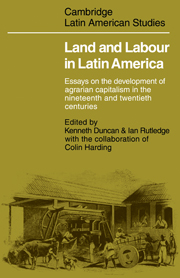 Land and Labourin Latin America
Land and Labourin Latin America Book contents
- Frontmatter
- Contents
- List of tables
- List of figures
- List of maps
- Acknowledgements
- 1 Introduction: patterns of agrarian capitalism in Latin America
- PART I THE TRANSITION FROM TRADITIONAL HACIENDA TO CAPITALIST ESTATE
- PART II THE DEVELOPMENT OF A PLANTATION ECONOMY WITH LABOUR RECRUITMENT FROM HIGHLAND PEASANT COMMUNITIES
- PART III THE DEVELOPMENT OF COMMERCIAL AGRICULTURE USING EUROPEAN IMMIGRANT LABOUR
- PART IV THE TRANSITION FROM SLAVE PLANTATION TO CAPITALIST PLANTATION
- PART V POSTSCRIPT
- Glossary of Spanish and Portuguese terms used in the text
- Weights and measures
- Notes on contributors
- Indexes Subjects
- Authors
PART IV - THE TRANSITION FROM SLAVE PLANTATION TO CAPITALIST PLANTATION
Published online by Cambridge University Press: 07 May 2010
- Frontmatter
- Contents
- List of tables
- List of figures
- List of maps
- Acknowledgements
- 1 Introduction: patterns of agrarian capitalism in Latin America
- PART I THE TRANSITION FROM TRADITIONAL HACIENDA TO CAPITALIST ESTATE
- PART II THE DEVELOPMENT OF A PLANTATION ECONOMY WITH LABOUR RECRUITMENT FROM HIGHLAND PEASANT COMMUNITIES
- PART III THE DEVELOPMENT OF COMMERCIAL AGRICULTURE USING EUROPEAN IMMIGRANT LABOUR
- PART IV THE TRANSITION FROM SLAVE PLANTATION TO CAPITALIST PLANTATION
- PART V POSTSCRIPT
- Glossary of Spanish and Portuguese terms used in the text
- Weights and measures
- Notes on contributors
- Indexes Subjects
- Authors
Summary
The decline and eventual abolition of slavery in northeast Brazil and the subsequent technological changes in the sugar industry are discussed by Jaime Reis and Peter Eisenberg in the first two papers of this section. Both make clear the extent to which almost all the agricultural land in this region was controlled by the planter oligarchy, thereby leaving the ex-slaves and other classes of free labourers few opportunities to escape from work on the plantations, which remained virtually their only source of income and employment. Moreover, ecological conditions discouraged the ex-slaves from migrating in large numbers away from the coastal sugar zone into the interior, for the arid backlands of the sertao already carried a surplus population which, unable to eke out more than bare living from the region's meagre and uncertain resources, was itself actually seeking to migrate (albeit seasonally) towards the sugar cane areas. Eisenberg's paper contains a broad general analysis of the economic factors affecting the Brazilian sugar industry in this period of crisis and change, and some useful comparisons are made with the Cuban sugar cane industry. In contrast, Reis's paper presents a more detailed study of the social relations of production within the changing plantation system, with particular reference to the slow but steady transition from the use of slaves to moradores as the major source of agricultural labour.
Whereas in northeast Brazil the process of agrarian change seems to have been relatively smooth and untraumatic (at least from the point of view of the landowners), Michael Taussig shows that in the Cauca Valley of Colombia the elimination of Negro slavery initially resulted in a very considerable degree of economic and social disruption in the plantation system.
- Type
- Chapter
- Information
- Land and Labourin Latin AmericaEssays on the Development of Agrarian Capitalism in the nineteenth and twentieth centuries, pp. 343 - 344Publisher: Cambridge University PressPrint publication year: 1978


